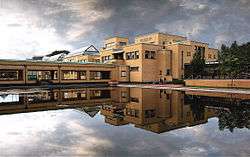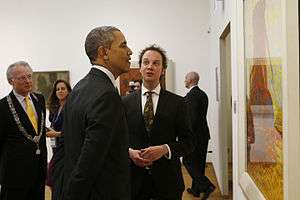Kunstmuseum Den Haag
The Kunstmuseum Den Haag is an art museum in The Hague in the Netherlands, founded in 1866 as the 'Museum voor Moderne Kunst'. Later, until 1998, it was known as 'Haags Gemeentemuseum', and until the end of September 2019 as 'Gemeentemuseum Den Haag'. It is renowned for its large Mondrian collection, the largest in the world. His last work, Victory Boogie-Woogie, is on display here.
 Museum building designed by H.P. Berlage | |
 Location in South Holland in the Netherlands | |
| Former name | Museum voor Moderne Kunst |
|---|---|
| Established | 29 May 1866 |
| Location | Stadhouderslaan 41 The Hague, Netherlands |
| Coordinates | 52°5′22″N 4°16′50″E |
| Type | Art museum |
| Visitors | 415.000 (2018)[1]
|
| Director | Benno Tempel |
| Architect | Hendrik Petrus Berlage |
| Website | www |
The museum building was constructed between 1931–1935, designed by the Dutch architect H.P. Berlage.[2]
GEM (museum for contemporary art) and Fotomuseum Den Haag (The Hague museum for photography) are part of the Kunstmuseum, though not housed in the same building and with a separate entrance fee.[3][4]
Collection

Modern art
The museum's collection of modern art includes works by international artists (Edgar Degas, Claude Monet, Pablo Picasso, Egon Schiele, Frank Stella, Henri Le Fauconnier and many others) and Dutch artists (Constant, Vincent van Gogh, Johan Jongkind, Pyke Koch, Piet Mondriaan, Charley Toorop, Jan Toorop, and many others).[5]
Pottery and Glass art

The Hague Municipal Museum has one of the largest collections of Dutch Delftware in the world. Selected pieces of the collection are on display at the a permanent gallery which represent Dutch art in the 'Golden Age'.[6] The museum also holds one of the largest collections of Persian ceramics and glasses in Europe.[7]
Print Room
The museum has a collection of 19th and 20th century prints, posters and drawings, containing around 50,000 items. It comprises works by Dutch artists such as Co Westerik and Jan Toorop, as well as works by Rodolphe Bresdin, Ingres, Paul Klee, Toulouse-Lautrec, Odilon Redon and others. A selection is on view in the print room.[8]
Fashion
The collection of fashion items, accessories, jewellery, drawings and prints includes historical items as well as modern ones by designers such as Cristóbal Balenciaga, Gabrielle Chanel, André Courrèges, John Galliano and Fong Leng. For reasons of conservation items are only shown at temporary exhibitions.[9]
Music
The music collection includes a large collection of musical instruments and a music library, with an emphasis on European music.[10] The collection mainly includes fortepiano's, wind and plucked string instruments. Also, there are instruments from other cultures and contemporary electronic instruments. In addition, the collection includes prints, posters, drawings and photographs relating to 'performance practice'. Part of the collection came from the Scheurleer Music History Museum, that lasted from 1905 to 1935, and was purchased after the bankruptcy of Scheurleer & Zoonen in 1932.
Images from the museum
%2C_oil_on_canvas%2C_73_x_60_cm%2C_Gemeentemuseum%2C_The_Hague._Exhibited_at_the_Armory_Show%2C_New_York%2C_Chicago%2C_Boston_1913.jpg) Pablo Picasso, 1910, Woman with Mustard Pot (La Femme au pot de moutarde), oil on canvas, 73 x 60 cm. Exhibited at the Armory Show, New York, Chicago, Boston 1913
Pablo Picasso, 1910, Woman with Mustard Pot (La Femme au pot de moutarde), oil on canvas, 73 x 60 cm. Exhibited at the Armory Show, New York, Chicago, Boston 1913 Jürgen Partenheimer, Weltachse V, installation Gemeentemuseum Den Haag, 1999
Jürgen Partenheimer, Weltachse V, installation Gemeentemuseum Den Haag, 1999 Clavicytherium by Albert Delin ca.1760
Clavicytherium by Albert Delin ca.1760
References
- (in Dutch) (PDF) Jaarverslag 2018, Kunstmuseum Den Haag, 2018. Retrieved on 2019-12-04.
- "Haags Gemeentemuseum (rijksmonument #461450)". Monumentenregister (in Dutch). Rijksdienst voor het Cultureel Erfgoed.
- "GEM Museum voor actuele kunst".
- "Fotomuseum Den Haag".
- "Gemeentemuseum: Modern Art".
- "Delftware Wonderware".
- "Persian Ceramics: Treasure of The Hague Municipal Museum".
- "Gemeentemuseum: Print Room".
- "Gemeentemuseum: Fashion".
- "Gemeentemuseum: Music".